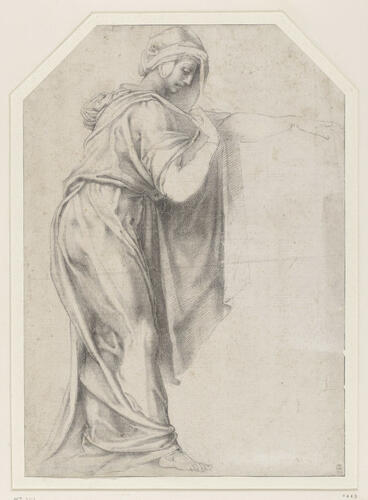-
1 of 253523 objects
A draped female figure c.1540-50
Black chalk | 36.7 x 26.1 cm (sheet of paper) | RCIN 990443

Attributed to Daniele Ricciarelli da Volterra (c. 1509-66)
A draped female figure c.1540-50

Attributed to Daniele Ricciarelli da Volterra (c. 1509-66)
A draped female figure c.1540-50


-
A drawing of a standing female figure, profile right, in drapes all'antica.
The drawing was anciently attributed to Michelangelo (inscription on verso; see below) and an old pencil inscription on the mount read 'Copy from Daniele da Volterra (fresco S Trinita Rome)'. Popham (in P&W) however thought that the drawing may in fact be an original work by Daniele, and possibly a study for one of the basamento figures formerly painted in the Orsini chapel in the Trinità dei Monti, Rome. The contract for the chapel decoration was signed on 1 December 1541 and the frescoes were probably completed by August 1548. The stucco frieze was begun by Perino del Vaga, but the greater part was made by Daniele da Volterra. Daniele's decoration of that chapel has been almost entirely destroyed (only the Deposition survives); two pairs of basamento figures were etched in 1771-2 in the Abbé de St.-Non's Fragmens choisis dans les plus interessans des Palais et des Eglises d'Italie - Premiere Suite (the title etching) and Deuxieme Suite (unnumbered). The present figure does not correspond with any of those four, but the attitude and character are so similar that it may be presumed to be either a rejected study for one of these, or the finished study for another (if there were more than four).
A copy of the drawing is in the Musée Bonnat (inv. 1221; J. Bean, Bayonne, Musée Bonnat: les dessins italiens de la collection Bonnat, 1960, no. 184). The attribution to Daniele was rejected by S.H. Levie, Der Maler Daniele da Volterra, PhD thesis, Cologne 1962, pp.166f, and supported by P. Barolsky, Daniele da Volterra, 1979, p.119.
The drawing is inscribed in pen on the verso Michel Angelo Bonarota 8.1, in the hand associated with the English seventeenth-century dealer William Gibson, whose inscriptions and characteristic ‘price codes’ can be found on at least 51 drawings in the Royal Collection. Jonathan Richardson the Elder explained Gibson's pricing system whereby the second figure is the unit - 1 for a shilling, 2 for half a crown, 3 for a crown (5 shillings) and 4 for a pound (20 shillings); a price code of 8.1. would indicate that the drawing was priced at 8 shillings.
Like many other drawings with an English seventeenth-century provenance, the top corners of this sheet have been cropped, perhaps to be placed in a decorative mount. This cropping could be indicative of a particular collector or could represent a more general fashion adopted by English collectors at that time; some 14 of the 51 drawings in the Royal Collection with Gibson inscriptions have been cropped in this way.Provenance
William Gibson (1644/5-1702); probably acquired by Charles II. Listed in George III's 'Inventory A,' c.1800-20, p. 43 ('Mich: Angelo Buonarroti. / Tom. I.' (c. 1802): '8. Study for the Drapery of a Female Figure'.
-
Creator(s)
Previously attributed to (artist)Acquirer(s)
-
Medium and techniques
Black chalk
Measurements
36.7 x 26.1 cm (sheet of paper)
Category
Object type(s)